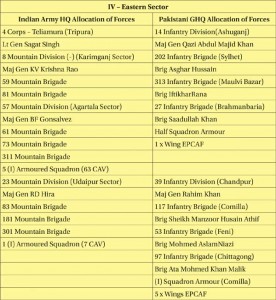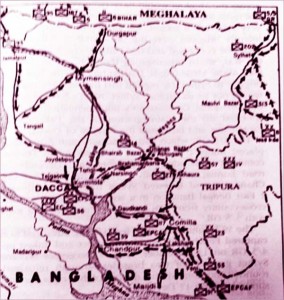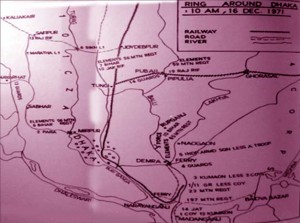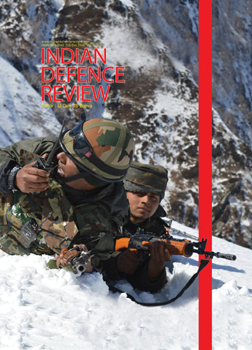Alternatively, the better ‘Attack Plan’ for 33 Corps would have been:
- Deploy 340 (I) Infantry Brigade in Balurghat Bulge and task it to later progress the operations launched by 66 Mountain Brigade North of Hilli as actually executed.
- 20 Mountain Div with 202 and 165 Mountain Brigades to attack from Gajol-Nischitapur area on the Patnitola-Mahadebpur – Naogaon-Sherpur-Sirajgang Axis.
This would have given 33 Corps the chance to undertake the game-changing ‘Deep Operations’ option more speedily and over more suitable terrain, where the enemy deployment was in lesser strength. The ‘obvious’ attack axis which was selected from the Balurghat Bulge, i.e. onto Hilli-Goraghat-Gaibanda should have been best avoided as the enemy deployment and state of defences were better which considerably delayed progress of operations and enhanced casualties. However, HQ Eastern Command had not given either support or encouragement for such a Plan, which would have posed the biggest to the final Theatre Objective of Dacca from this sector of operations.
The destruction of the Phulchari Ghat Ferry by the IAF and ground troops was also unwarranted and short-sighted, as this precluded the option of switching over of a Brigade Group of 33 Corps across River Jamuna to join the “Race for Dacca”.
To cover this 185-km frontage sector extending from the Eastern Bank of the River Jamuna to the Western border of the mountainous Sylhet District and starting from the plains immediately South of the Khasi and Jaintia Hills on the Indian side; though the terrain had very few natural obstacles before reaching Dacca 160 km away, the Indian allocation of forces seemed to have been an afterthought! Considering the fact that the Pakistani deployment here was also light and they possessed no armour except in the Dacca area, this points to a serious ‘mistake’ by the Indian Army’s Military Operations Directorate and the HQ Eastern Army Command’s General Staff Branch. It is so obvious that the ‘Terrain Analysis’ and the ‘Intelligence Appreciation’ from the enemy’s perspective about the possible outcome of operations in this sector had not been properly done, as borne out by the actual course of operations. Ideally, the Indian Army should have assigned the following Groupings to this sector:
- 1 x Mountain Division (-) – Preferably 27 Mountain Division.
- 1 x (I) Infantry Brigade (-) – Possibly 50(I) Para Brigade Group.
- 1 x (I) Squadron Armour.
- 1 x (I) Composite Mechanised Reconnaissance Squadron.
Conduct of Operations
‘95 Mountain Brigade’ cleared the Pakistani Kamalpur Border Strongpoint on December 04, and reached the Brahmaputra River by December 07. This river was crossed on December 08 and Blocks established South of the Pakistani Jamalpur fortress. Two other infantry battalions were subsequently built up across the river and attacks launched on December 10. The Pakistani 93 Infantry Brigade which was putting up a stubborn fight at Jamalpur and Mymensingh was suddenly ordered by General Niazi on December 10 to withdraw and reinforce Dacca, following Indian heli-borne landings at Raipur/ Narsingdi and reports of in the international media that a major Indian para-drop operation near Dacca was in the offing. The para-drop of an Indian Battalion Group actually occurred near the Poongli Bridge short of Tangail on the evening of December 11. They successfully blocked the withdrawal of Pakistani 93 Infantry Brigade rear elements to Dacca.
 Similarly, a Battalion from FJ Sector advancing on Haluaghat-Mymensingh axis seized Mymensingh fortress on December 11 and linked up with Indian 93 Mountain Brigade forward elements at Madhupur on December 12. Thereafter, 6 SIKHLI (ex 167 Mountain Brigade/5 Mountain Div), which had been released by Army HQs and had reached the operational area, was also placed under 93 Mountain Brigade. It captured Kaliakhar on December 13 and also took the Pakistani Brigade Commander captive near Dhamrai. It further advanced up to Joydebpur on December 15. 167 Infantry Brigade arrived and built up there by December 16, for the assault on Dacca. 13 GUARDS (of 95 Mountain Brigade) was placed under command of FJ Sector on December 13 and it cleared Sabhar by December 15. 2 PARA was also placed under FJ Sector on December 13 and they closed in on the Mirpur Bridge on River Turag on the outskirts of Dacca by December 15.
Similarly, a Battalion from FJ Sector advancing on Haluaghat-Mymensingh axis seized Mymensingh fortress on December 11 and linked up with Indian 93 Mountain Brigade forward elements at Madhupur on December 12. Thereafter, 6 SIKHLI (ex 167 Mountain Brigade/5 Mountain Div), which had been released by Army HQs and had reached the operational area, was also placed under 93 Mountain Brigade. It captured Kaliakhar on December 13 and also took the Pakistani Brigade Commander captive near Dhamrai. It further advanced up to Joydebpur on December 15. 167 Infantry Brigade arrived and built up there by December 16, for the assault on Dacca. 13 GUARDS (of 95 Mountain Brigade) was placed under command of FJ Sector on December 13 and it cleared Sabhar by December 15. 2 PARA was also placed under FJ Sector on December 13 and they closed in on the Mirpur Bridge on River Turag on the outskirts of Dacca by December 15.
 To coordinate the assault on Dacca, Army HQs placed 101 Communication Zone under the command of HQ 4 Corps on December 15. After the surrender of the Pakistani forces was agreed to by General Niazi, 4 PARA was the first Indian combat unit to enter Dacca and oversee the ‘unconditional surrender’ ceremony at the Ramna Racecourse at 1655 hours IST on December 16.
To coordinate the assault on Dacca, Army HQs placed 101 Communication Zone under the command of HQ 4 Corps on December 15. After the surrender of the Pakistani forces was agreed to by General Niazi, 4 PARA was the first Indian combat unit to enter Dacca and oversee the ‘unconditional surrender’ ceremony at the Ramna Racecourse at 1655 hours IST on December 16.
Tasks Assigned to GOC Indian 4 Corps
- Make rapid advances up to River Meghna and seize the ports of Chandpur, Daudkandi and the ferry at Sherpur and Sadipur on River Surma towards Sylhet.
- Occupy Brahmanbaria, Sylhet, Comilla, Chandpur and push towards Chittagong.
Progress of Operations
8 Mountain Div. was tasked to capture Maulvi Bazar, reduce Sylhet and thereafter progress operations towards Brahmanbaria. 81 Mountain Brigade captured Maulvi Bazar on December 09, 1971 and evicted Pak 313 Infantry Brigade which was forced to pull back. It then pursued the Pakistanis across River Kusiyara seizing the Sadipur/Sherpur Ferry and reached the outskirts of Sylhet from the South. General Niazi’s plan was for 313 Infantry Brigade to carry out a tactical withdrawal towards Dacca but both the GOC Pakistani 14 Div and 313 Infantry Brigade Commander opposed this proposal as impractical and did not comply. They were removed from command.
Indian 59 Mountain Brigade had captured Kalaura strongpoint to the North of Sylhet by December 07. Based on wireless intercepts that the Pakistani GHQ had ordered the Sylhet Garrison to fall back on Brahmanbaria, 4/5 GR was airlifted to the area SE of Sylhet across River Surma on the morning of December 08. They established a firm base there. 59 Mountain Brigade which had been pulled South as Corps Reserve, was again released back to 8 Mountain Div on December 10, and they resumed the attack onto Sylhet from the SE direction. Linkup was achieved with 4/5 GR by December 14. The Sylhet Garrison consisting of 6,500 Pakistani troops including three Brigadiers surrendered to Major General Krishna Rao on December 16. The BSF played a gallant role in these operations.
57 Mountain Div.: In this sector, Akhaura was held by 12 FF/27 Pakistani Brigade. It was captured by 18 RAJPUT/311 Mountain Brigade by the morning of December 04 after an epic fight. 73 Mountain Brigade was tasked to capture Brahmanbaria, while 311 Mountain Brigade secured the road leading to Brahmanbaria from the South. 73 Mountain Brigade seized Brahmanbaria on December 07. The next objective for 57 Mountain Div was Ashuganj on the Eastern bank of River Meghna, near the Coronation Rail Bridge leading to Bhairab Bazar on the West of River Meghna. On the morning of December 09, the Pakistani HQ 14 Infantry Div withdrew to Bhairab Bazar and blew up the Rail Bridge on the Meghna, leaving Pakistani 27 Brigade stranded on the Eastern side. This incensed General Niazi and he sacked the Div. Commander. 311 Mountain Brigade mounted a fierce attack on Ashuganj on December 09 with 18 RAJPUT and 10 BIHAR, which was beaten back by Pakistani 27 Brigade with 33 BALUCH and 12 FF. Thereafter, during the night of December 09-10, Pakistani 27 Brigade successfully crossed over to Bhairab Bazar side using country boats. Ashuganj was occupied by 311 Mountain Brigade on December 10.
23 Mountain Division had concentrated in South Tripura and in preliminary operations, cleared the Belonia Bulge by December 02. Facing it was Pakistani 39 Infantry Div, with 117 Infantry Brigade in the Comilla Sector and 53 Infantry Brigade in the Laksham Sector. The clearance of the Belonia Bulge created a false impression in the Pakistani commanders’ minds that the Indians would seize Feni next. So they moved the bulk of Pakistani 53 Brigade from the Laksham Sector towards Feni on December 03-04. When these reports reached Lt Gen Sagat Singh, he decided to seize the opportunity and make a dash towards the river port of Chandpur through the gap between the Pakistani deployment at Lalmai and Laksham. He, therefore, changed his plans, as follows:
• 61 Mountain Brigade (Corps Reserve ex 57 Mountain Div) along with a squadron of tanks was allotted to 23 Mountain Div and was tasked to contain the Pakistani deployment in the Lalmai Heights and Mynamati Cantt (West of Comilla) area.
• 83 Mountain Brigade was tasked to protect the Southern flank of 23 Div operations and cut the Laksham-Feni road.
• 301 Mountain Brigade was tasked to advance through the gap between Comilla and Lalmai along with 1 (I) Armoured Squadron, and make a dash towards Chandpur Ferry (also the location of Pakistani 39 Infantry Div HQ).
• 181 Mountain Brigade was tasked to reduce Laksham.
By December 05, 61 Mountain Brigade had penetrated North of Comilla and cut the road to Dacca. Thereafter, it built up North and West of Mynamati Cantt along with armour. This forced Brigadier Atif to pull back his 117 Infantry Brigade from Comilla and Lalmai Heights to the fortress of Mynamati, where they remained bottled-up till the end of the War. Comilla fell to 61 Mountain Brigade on December 09. 61 Mountain Brigade quickly exploited this and sent 12 KUMAON Battalion Group towards the Meghna River and seized the vital Daudkandi Ferry on December 09. This was a masterstroke.
39 BALUCH/53 Pakistani Infantry Brigade panicked and withdrew from Laksham to Mynamati on December 08. There it remained bottled up. This action had a cascading effect and 25 FF/Pak 117 Infantry Brigade which was deployed in the Lalmai Heights area (after being attacked by 301 Mountain Brigade) also fell back and surrendered to 61 Mountain Brigade at Comilla on December 12 after it failed to reach Mynamati.
On December 10, 181 Mountain Brigade captured Laksham. Thereafter, it joined the attack on Mynamati fortress from the South, till the Pakistani garrison surrendered on December 16. After the eviction of Pakistani 53 Infantry Brigade from Laksham area, 83 Mountain Brigade was ordered to progress operations towards Chittagong. It was assisted by the ad hoc ‘Kilo Force’ Grouping consisting of Indian Army, East Bengal Regiment Battalions and Mukti Bahini columns. The Pakistani Garrison at Chittagong surrendered on December 17.
301 Mountain Brigade carried out the deadliest operation of the War. At the onset of the War, the Brigade cleared Mian Bazar, South of Comilla. 25 FF was thereafter wiped out in the Lalmai Heights area and its CO captured. On December 08, 301 Brigade captured Comilla airfield and cleared the town after bitter fighting. Thereafter, it raced towards Chandpur River Port and smashed the HQ of Pakistani 39 Infantry Division on December 09. This action made General Niazi lose his nerve, as he was barely able to evacuate the Divisional Commander by a steamer. The GOC got injured in an airstrike and was later sent out of East Pakistan by helicopter to Burma. The striking success of Indian 4 Corps in reaching River Meghna at Ashuganj, Daudkandi and Chandpur by December 09, in spite of stiff opposition and bad terrain, electrified Eastern Command and caused an irretrievable dip in Pakistani morale.
Operations across the Meghna River
Sensing the uncertainty that gripped the Pakistani forces, Lt Gen Sagat Singh heli-lifted 4 GUARDS/311 Mountain Brigade/57 Mountain Div along with a Light Troop of artillery to ‘Raipura’ across River Meghna, about ten kilometres South of Bhairab Bazar on December 09 itself. They moved ten kilometres further South unopposed and established a Firm Base near ‘Narsingdi’ on December 10. 73 Mountain Brigade/57 Mountain Div started crossing River Meghna in country boats South of Bhairab Bazar on December 09 and contained Pakistani deployment there.
311 Mountain Brigade including a major part of its supporting artillery completed its build up in Narsingdi area by December 11, both by heli-lift and by country boats to cross River Meghna. Narsingdi was overrun on December 12 and both the rail and road bridges there were captured intact. On December 13, the rail bridge over the Lakhya River connecting to Tungi was captured and 73 Mountain Brigade advanced further. By the evening of December 14, 65 Mountain Regiment under 311 Mountain Brigade had moved up its guns and had started pounding targets located in the heart of Dacca Cantt.
 On December 13, Lt. Gen. Sagat Singh had switched 301 Mountain Brigade/23 Mountain Div from Chandpur to Daudkandi due to the availability of river crossing boats there and by December 15, assisted by heli-lift, the Brigade concentrated near Baidya Bazar. It stormed across the Sitalakhya River on the morning of December 16 and started probing Dacca proper from the East, till news of Pakistan’s decision to surrender was received by noon. Thus, Sagat Singh had succeeded in moving 73 and 311 Mountain Brigades to the Northeast of Dacca and 301 Mountain Brigade to the East of Dacca by December 16, besides 93 Mountain Brigade and FJ Sector forces which had reached North of Dacca, to unleash the final assault on Dacca from December 17 onwards had Niazi not agreed to the unconditional surrender.
On December 13, Lt. Gen. Sagat Singh had switched 301 Mountain Brigade/23 Mountain Div from Chandpur to Daudkandi due to the availability of river crossing boats there and by December 15, assisted by heli-lift, the Brigade concentrated near Baidya Bazar. It stormed across the Sitalakhya River on the morning of December 16 and started probing Dacca proper from the East, till news of Pakistan’s decision to surrender was received by noon. Thus, Sagat Singh had succeeded in moving 73 and 311 Mountain Brigades to the Northeast of Dacca and 301 Mountain Brigade to the East of Dacca by December 16, besides 93 Mountain Brigade and FJ Sector forces which had reached North of Dacca, to unleash the final assault on Dacca from December 17 onwards had Niazi not agreed to the unconditional surrender.
This was a great feat of arms for any Field Commander practicing ‘Deep Operations Theory’ and overcoming obstacles-ridden country over a distance of 150-200 km. His menacing manoeuvres caused a ‘freeze mentality’ to set in amongst senior Pakistani commanders in the Eastern Theatre, leading to near complete breakdown of Pakistani morale and the ‘will to fight’. The crossing of the River Meghna which is over 4,000 feet wide at its narrowest stretch, from December 09-10 onwards, without a bridge being available, was a game-changer which ultimately led to the liberation of Bangladesh.
4 Corps under Lt. Gen. Sagat Singh restored the pride of Indian Army after the disaster of the 1962 India-China War and the stalemated 1965 India-Pakistan Conflict, when the aggressors had got away scot-free. As a tribute to him, Lt Gen JS Aurora first went to Agartala by helicopter to pick him and his Divisional Commanders before landing at Dacca for the surrender ceremony, which thereby got delayed. From the Pakistani side, General Aurora was given the ‘Guard of Honour’ by 2 Commando Battalion (later renamed SSG) led by their Commanding Officer. The surrender ceremony was witnessed by the troops of 2 PARA and 6 BIHAR (FJ Sector/101 Communication Zone), 13 GUARDS (95 Mountain Brigade/101 Communication Zone), 4 GUARDS (311 Mountain Brigade/ 57 Mountain Div) and 5 (I) Armoured Squadron (63 CAV and 311 Mountain Brigade/ 57 Mountain Div. It can be said in passing, that Lt. Gen. Sagat Singh became the undisputed “Duke of Wellington” of India.
Conclusion
The need to understand the mechanics of conduct of ‘Deep Operations’ is paramount while undertaking offensive operations. “Limited War” and “Limited Objectives” are mindsets of the mediocre who have not grasped the essence of Major Staff Duties which is to be innovative, gather momentum and be unpredictable after operations commence and not get tied down in predictive methodologies. No War is ever fought and won with adequate resources. However, the fact that India’s Eastern Army Command went to war without possessing an Independent Armoured Brigade and an Independent Amphibious Brigade in its ORBAT stood out as glaring failings. The purpose of doing such an ‘unsparing’ study of the Bangladesh War operations is to drive home the point that if we have to fight the next War, our higher commanders should not be found wanting in the skills needed to undertake ‘Deep Operations’.
References
- The India – Pakistan War of 1971, A History; S N Prasad & U P Thapliyal; Natraj Publishers, Dehradun, 2014.
- Surrender at Dacca – Birth of a Nation; Lt Gen J F R Jacob (Retd); Manohar Publishers, New Delhi, 1997.
- The Betrayal of East Pakistan; Lt Gen A A K Niazi (Retd); Oxford University Press, Karachi, 1998.
- The Liberation of Bangladesh; Maj Gen Sukhwant Singh (Retd); Lancer Publishers, New Delhi, 1980.
- Victory in Bangladesh; Maj Gen Lachman Singh (Retd); Natraj Publishers, Dehradun, 1981.







Sir, you may like to correct a major mistake, I take it it must be a typing error, it’s 2 Para which entered Dhacca first and NOT 4 Para. Ref third paragraph of Conduct of Operations.
Regards
A great piece for future students